Blog Post # 27
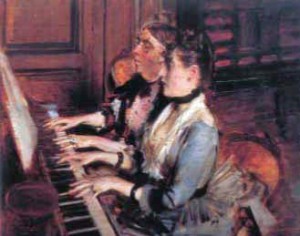
I just returned from practicing a piano duet with a wonderful friend who loves the sweet cadences and depth of feeling that pour from heart to fingers to keys to ears as much as I do. What an absolute joy to share one piano keyboard to make beautiful music together!
When my sister, Karen, and I were young, we often “jammed” at the piano, later adding other instruments to the mix. It was at the piano that we learned to sync our hands and hearts. From Chopsticks, and Heart and Soul, we graduated to our own rendition of a tune from the now defunct Disney attraction, Country Bear Jamboree, banging out the song with knee-slapping, joyful abandon. We felt the other’s timing and touch so well, we could duplicate the unison parts with perfect accuracy. This translated to other parts of life: finishing each other’s sentences, and reading each other’s thoughts from across the room.
It was my mother’s love of music, combined with her proclivity toward the piano in particular, that bred a long line of piano players among her posterity. Duets were a natural outcropping from the bedrock of piano-loving family members, and remind me of a time when my mother was still alive. She was a fine pianist and loved to play hours at a time. I recall falling asleep to piano sonatas and waking on a Sunday morning to sacred hymns. I would come home from school to find my mother and one or the other of her two piano-playing friends at my mother’s baby grand, their hands executing complicated dance moves as they flew across the ivories revealing a classical masterpiece arranged for four hands. I knew the expectation—I was to wait until they stopped before interrupting them for anything, with the exception of an emergency. Some of those pieces lasted ten or fifteen minutes—a long time to wait for an anxious young mind. After waiting what seemed an eternity, I finally interrupted—Sheryl had been hanging on the phone wondering if I could come over to play! If that wasn’t an emergency, I don’t know what was!
When I grew older, my mother invited me to join her playing piano duets. She had high standards of excellence, and insisted I fix any technical errors at the very moment they were discovered—repeatedly playing a bar or two until I had mastered the phrase. I was never technically adept, but I made up for it with unsurpassed expressivo (feeling), for I certainly felt the beauty and emotion of the music, even if I couldn’t always play the notes correctly. Still, she wanted me by her side, and over time, I improved.
After I had a family of my own, my mother and I performed at a church function an involved arrangement of Stars and Stripes Forever (the famous, easily recognizable march by John Phillip Sousa). It was a marvelous experience! I think the rehearsing was as much or more fun than the performance. A unique kind of bond forms when playing piano duets. There’s something about triumphing over difficult passages, hearing rough sight-reading sessions resolve into a harmonious whole, and feeling the emotional drama unfold with dynamic expression. I think the most satisfying part is when you feel an emotional connection to the music, and you know that an entirely different person sitting next to you is also feeling the music in exactly the same way you are, because you can anticipate and respond to what they’re feeling with perfect harmonious unity. (This doesn’t necessarily mean every note is perfectly executed, or that there is flawless technique. It means that two individuals are, for the moment, one in spirit.)
When grandchildren came along, besides building puzzles together, and intensely competitive games of Scrabble, my mother invited them to play duets with her. While several enjoyed this privilege, one grandchild in particular latched onto this opportunity. Amanda excelled in playing the classical cadences and disciplined execution of the pieces my mother most enjoyed, which was satisfying to my mother. They made a good team, sometimes performing at church, and frequently for the family. I will venture to guess that Amanda formed a uniquely intimate bond with her grandmother through these duets.
When my own children were comfortable enough with the piano, I did my best to wrangle them into playing duets with me, however most preferred going solo. It wasn’t until my youngest daughter Caity grew adept enough to participate that I found a duet partner among my children. Even during trying and difficult teenage times, we found common ground and a laughing place sitting at the piano together. Our repertoire ranged from Mozart to Joplin—all played with equally blatant disregard for correct technique and execution. What we lost in technical expertise we made up for in expression. We loved the dynamics of the theme from Mozart’s Symphony No.40, and Burgmüller’s Arabesque. They were our wide-awake pieces. We blew threw them at Nascar speed, and with a roar to equal the revving engines! Who can resist every piano student’s favorite, Ellmenreich’s Spinning Song? We couldn’t. We dashed through it with unparalleled velocity and vigor, laughing all the way. We didn’t limit ourselves to lively pieces, however. Once, when playing an arrangement of Erik Satie’s First Gymnopèdie (which is serenity itself) we became so sleepy, we literally dozed on the bench. A much as we liked the piece, we haven’t played it since.
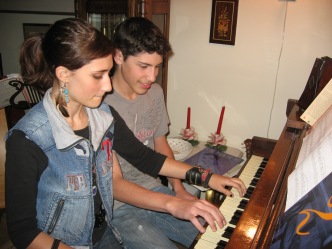
Two of my grandchildren. When they visit, one or the other, or both are always at the piano. I LOVE IT!
I found a much simpler arrangement of Stars and Stripes Forever that usually brought up the rear flank of our duets each time we played. Racing to beat each other to the end of the unison octaves forming the introduction, we immediately stalled into a belly-scraping crawl—plodding through the bars forming the first strain. The oom-pah-pahs in the secondo part (the bottom hands) were just too much for Caity to play full-speed, yet she insisted upon playing the lower part. I can attest to the fact that it really is difficult to play anything while laughing uncontrollably. We created more guffaws than music.Stars and Stripes became the backbone of hilarity for our duet sessions, and bridged difficult moments with laughter. How grateful I am for the time we spent at the piano together—we made more than music. We engraved musical notes into a stone monument of love. From time to time, when she is in town, we pull out the duet books and laugh it up all over again.

My mother with my sister, brother and me singing Christmas carols. Another great tradition at the piano.
There are many forms of the duet other than those played on the piano. Singing together creates a similar experience and bond, as well as playing other instruments together. But duets don’t have to be limited to music. Four hands, or two souls, when combined in a mutually appreciated and unified effort have the same effect. Duets can build structures, repair cars, prepare meals, dance, climb mountains, and serve others, to name a few.
I’ve watched as my husband Brad with one of our sons or daughters repaired a car, or saddled the horses for a ride. There’s something special in that. There’s a shared feeling of accomplishment and triumph when they both roll out from under the car with greasy hands, unitedly having solved a problem. Other kinds of problems may be solved, or circumvented in the process, as hands and minds repair, restore, or tune-up a thing of greater value—a relationship. There’s a connection when two set off alone on a moonlight ride. They return with a bit of moon inside of them—a bit of that light that warms and unites two hearts against the darkness.
The same may be true when four hands cook or bake side-by-side together, creating a culinary masterpiece or a simple peanut butter sandwich. It doesn’t matter what it is, it’s in the doing together that the bond is created.
There are other valuable duets: mentor and apprentice, hero and sidekick, teacher and student, peer and peer, friend and friend, parent and child, sister and brother, grandparent and grandchild, husband and wife.
One of the most rewarding duets outside of family relationships is when two work together to serve another. Four hands lifting and assisting someone in need, or lifting and serving each other. I have witnessed the power of this duet. It is strong, powerful, and life changing. When two combine their personal gifts and strengths to help another, they develop an unspoken bond. It’s difficult to pinpoint or explain, but I have experienced this, and can tell you that you feel one in purpose and one in heart when you lay aside other plans, and together with another like-minded person, give your time and energy to serve someone in need. You don’t even have to know the person with whom you serve prior to the moment of service. When you are finished, you see them through a familiar lens of understanding and compassion. You are like them and they like you—linked together in a uniquely special way. Four hands, two hearts, one mind.
It is not my purpose to lessen the value of trios, quartets, or other numerical combinations of people gathered for a unified experience. Not at all. Having participated in trios, quartets, double-quartets, and choirs composed of hundreds of souls, I can attest to the fact that there is a shared and harmonious unity in those experiences—even an unparalleled thrill to be part of such a group effort.
Playing solo also has its place and benefits. It can provide lessons of courage and accomplishment, and boost self-confidence. Spending hours alone at the piano, alone with one’s thoughts, and the beautiful and inspiring music created is therapeutic. Pounding out frustration and thinking things through are endeavors worked out on piano keys or through music throughout the ages. All of these are productive, purposeful, and enjoyable.
But when there’s only one, there’s no one else to share the thrill and joy of the experience. When alone, one’s focus tends to center on self—one’s vision narrows. One—a single entity—benefits from another who can provide balance and communion. With two, the focus shifts to the other. What is the other feeling? Will I be able to tune myself to his or her mind and heart? Will we be able to connect and create a thing harmonious and beautiful?
When we du-et, (do it) it’s magical!
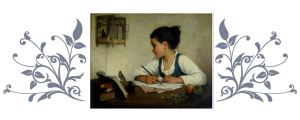 |
| © May 6, 2015 |
From the bottom of my heart, I thank you, dear friends, for reading.
Tweet

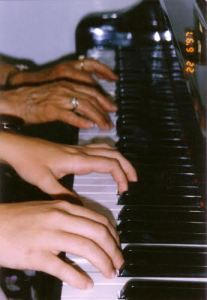
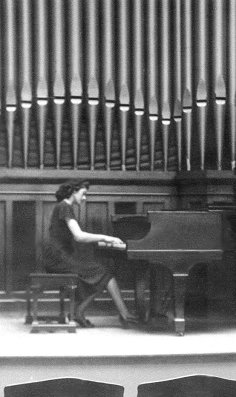
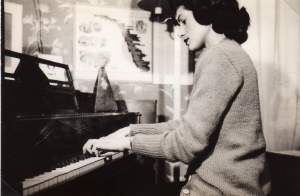


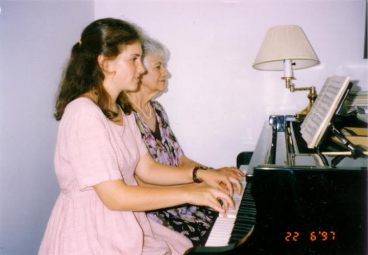
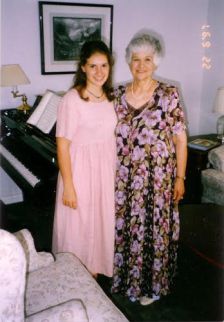

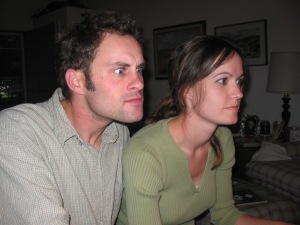
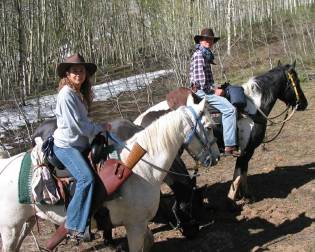
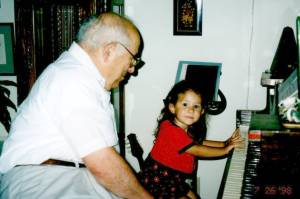
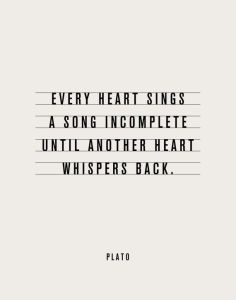
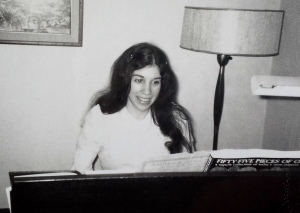
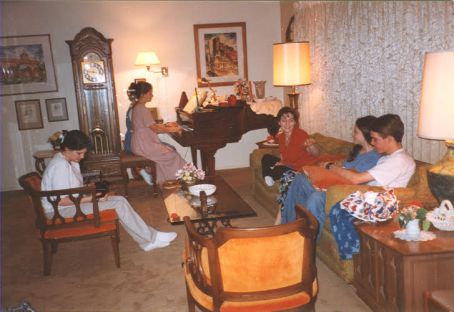

No comments:
Post a Comment